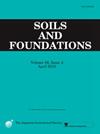利用两个土压力单元估算地层剪应力的前瞻性方法
IF 3.3
2区 工程技术
Q2 ENGINEERING, GEOLOGICAL
引用次数: 0
摘要
目前已开发出许多复杂的数值方法来评估土壤响应。然而,由于缺乏复杂原地条件下的应力-应变行为参考,很难对所获得的响应进行充分验证。例如,在长堤坝下,在深度上施加平面应变条件,同时允许向坡脚的水平位移和沉降,应力分量会因一个土体部分和相邻土体部分之间的相互作用而发生变化。由于这些应力条件本身是未知的,因此无法提供实验室实验数据来验证构成模型。因此,作者认为研究地层中的应力条件对于确认数值方法计算出的结果具有重要作用。有时会利用土壤应力单元来测量实验模型中的土压力,但事实证明这种测量往往不可靠或不现实。不过,最近对土压计的精确性进行了研究和改进。最近,我们进行了离心机试验,以估算地震时水平分层模型地面的剪应力。通过使用一对土压力计和莫尔应力圈的概念,可以估算出地面任意一点的剪应力。通过这种方法估算出的剪应力与根据地表假定土块的力平衡计算得出的结果十分吻合。因此,可以确认所提出的方法是估算地层剪应力的一种可行方法,值得进一步研究。本文章由计算机程序翻译,如有差异,请以英文原文为准。
Prospective method to estimate shear stress in the ground using two earth pressure cells
Many sophisticated numerical methods have been developed to evaluate soil responses. However, the lack of referential stress–strain behavior under complicated in-situ ground conditions makes it difficult to validate the obtained responses sufficiently. For example, under a long embankment, with imposing plane strain conditions in depth, allowing for both horizontal displacement toward the slope toe and settlement, the stress components change as a result of the interaction between one soil part and adjacent soil parts. Since those stress conditions themselves are unknown, no laboratory experimental data can be provided to validate a constitutive model. Therefore, the author considered that studying the stress conditions in the ground would play an important role in confirming the calculated results obtained by a numerical method. Soil stress cells have sometimes been utilized to measure the earth pressure in an experimental model, but such measurements have often proven to be unreliable or unrealistic. However, the preciseness of earth pressure meters has recently been examined and improved. Recently, centrifuge tests were conducted to estimate the shear stress in a horizontally layered model ground during shaking. By using a pair of earth pressure meters and the concept of Mohr’s stress circle, it was possible to estimate the shear stress at any point in the ground. The shear stress estimated by this method was seen to agree well with the results obtained by a calculation based on the force balances of the supposed soil blocks from the ground surface. As a result, it was confirmed that the proposed method is a promising way to estimate the shear stress in the ground and is worthy of further investigation.
求助全文
通过发布文献求助,成功后即可免费获取论文全文。
去求助
来源期刊

Soils and Foundations
工程技术-地球科学综合
CiteScore
6.40
自引率
8.10%
发文量
99
审稿时长
5 months
期刊介绍:
Soils and Foundations is one of the leading journals in the field of soil mechanics and geotechnical engineering. It is the official journal of the Japanese Geotechnical Society (JGS)., The journal publishes a variety of original research paper, technical reports, technical notes, as well as the state-of-the-art reports upon invitation by the Editor, in the fields of soil and rock mechanics, geotechnical engineering, and environmental geotechnics. Since the publication of Volume 1, No.1 issue in June 1960, Soils and Foundations will celebrate the 60th anniversary in the year of 2020.
Soils and Foundations welcomes theoretical as well as practical work associated with the aforementioned field(s). Case studies that describe the original and interdisciplinary work applicable to geotechnical engineering are particularly encouraged. Discussions to each of the published articles are also welcomed in order to provide an avenue in which opinions of peers may be fed back or exchanged. In providing latest expertise on a specific topic, one issue out of six per year on average was allocated to include selected papers from the International Symposia which were held in Japan as well as overseas.
 求助内容:
求助内容: 应助结果提醒方式:
应助结果提醒方式:


